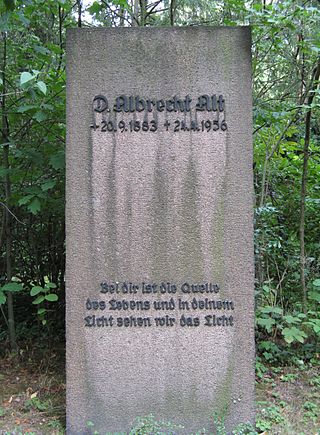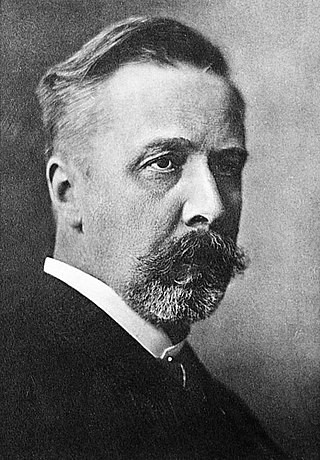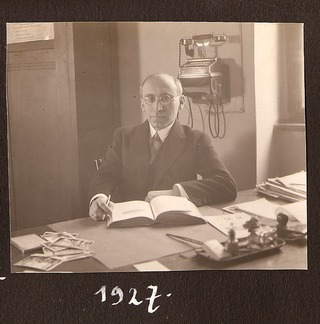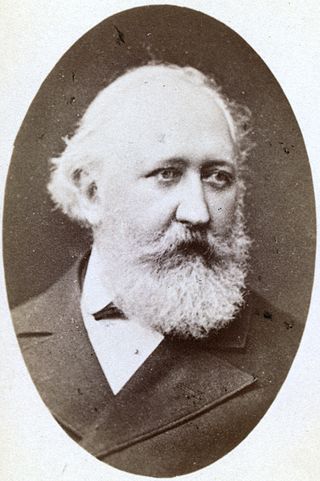Related Research Articles
In mathematics, a Mahlo cardinal is a certain kind of large cardinal number. Mahlo cardinals were first described by Paul Mahlo. As with all large cardinals, none of these varieties of Mahlo cardinals can be proven to exist by ZFC.

Arthur Peter König is a German physicist specialized in optics. In 1886, he published an empirical determination of the spectral sensitivity of the human rod and cone sensors with Conrad Dietrici.

Paul Emil Flechsig was a German neuroanatomist, psychiatrist and neuropathologist. He is mainly remembered today for his research of myelinogenesis.

Eberhard Frederich Ferdinand Hopf was a German mathematician and astronomer, one of the founding fathers of ergodic theory and a pioneer of bifurcation theory who also made significant contributions to the subjects of partial differential equations and integral equations, fluid dynamics, and differential geometry. The Hopf maximum principle is an early result of his (1927) that is one of the most important techniques in the theory of elliptic partial differential equations.

Paul Gustav Samuel Stäckel was a German mathematician, active in the areas of differential geometry, number theory, and non-Euclidean geometry. In the area of prime number theory, he used the term twin prime for the first time.

The Göttingen Academy of Sciences is the oldest continuously existing institution among the eight scientific academies in Germany, which are united under the umbrella of the Union of German Academies of Sciences and Humanities. It has the task of promoting research under its own auspices and in collaboration with academics in and outside Germany. It has its seat in the university town of Göttingen. Its meeting room is located in the auditorium of the University of Göttingen.

Albrecht Alt, was a leading German Protestant theologian.
Hermann August Krauss was an Austrian entomologist who specialised in Orthoptera and Dermaptera.

Albert Grünwedel was a German Indologist, Tibetologist, archaeologist, and explorer of Central Asia. He was one of the first scholars to study the Lepcha language.
Ludwig Lange was a German physicist.
August Conrady was a German sinologist and linguist. From 1897 he was professor at the University of Leipzig.
In mathematics, the Herglotz–Zagier function, named after Gustav Herglotz and Don Zagier, is the function

Gustav Heinrich Johann Apollon Tammann was a prominent Baltic German chemist-physicist who made important contributions in the fields of glassy and solid solutions, heterogeneous equilibria, crystallization, and metallurgy.

Helmut Franz Maria Kirchmeyer is a German musicologist, philologist and historian.

Hugo Iltis was a Czech-American biologist.
Johann Wilhelm Fück was a German Orientalist.

Filipp Vasilievich Ovsyannikov was the first Russian histologist and the founder of sturgeon breeding.

The Agušaya Hymn or Song of Agušaya is an Old Babylonian literary work, a “song of praise”, written in the Akkadian language concerning the goddess Ištar, identified with the serpent deity Irnina. It may have been called “the Snake has Turned” in antiquity, as it has ú-ta-arMUŠ inscribed at the top edge at the beginning. It is extant on two unprovenanced tablets, designated A and B, the latter of which includes a request for eternal life for king Hammurabi, on the fifth column, 26th line, for whom it is thought to have been composed as an epic hymn of celebration of “the mad dancer in battle”. It is arranged into ten kirugú-stanzas and six ĝešgiĝal-antiphons as lyrical retorts, the numbering of which suggest that the work extends over the two tablets, although the second may not be the actual sequel of the first as the first is an eight column tablet while the second only has six columns and there are apparently subtle differences in late Old Babylonian cursive cuneiform distinguishing them, suggesting tablet A is the younger copy.
Wilhelm Gross was an Austrian mathematician, known for the Gross star theorem.
Rudolf Kötzschke was a German historian who founded the Seminar for Regional History and Settlement Studies in Leipzig, the first regional history institution at a German university.
References
- ↑ Short biography of Paul Mahlo, Deutsche Mathematiker-Vereinigung (in German), retrieved 2010-04-21.
- ↑ Paul Mahlo at the Mathematics Genealogy Project